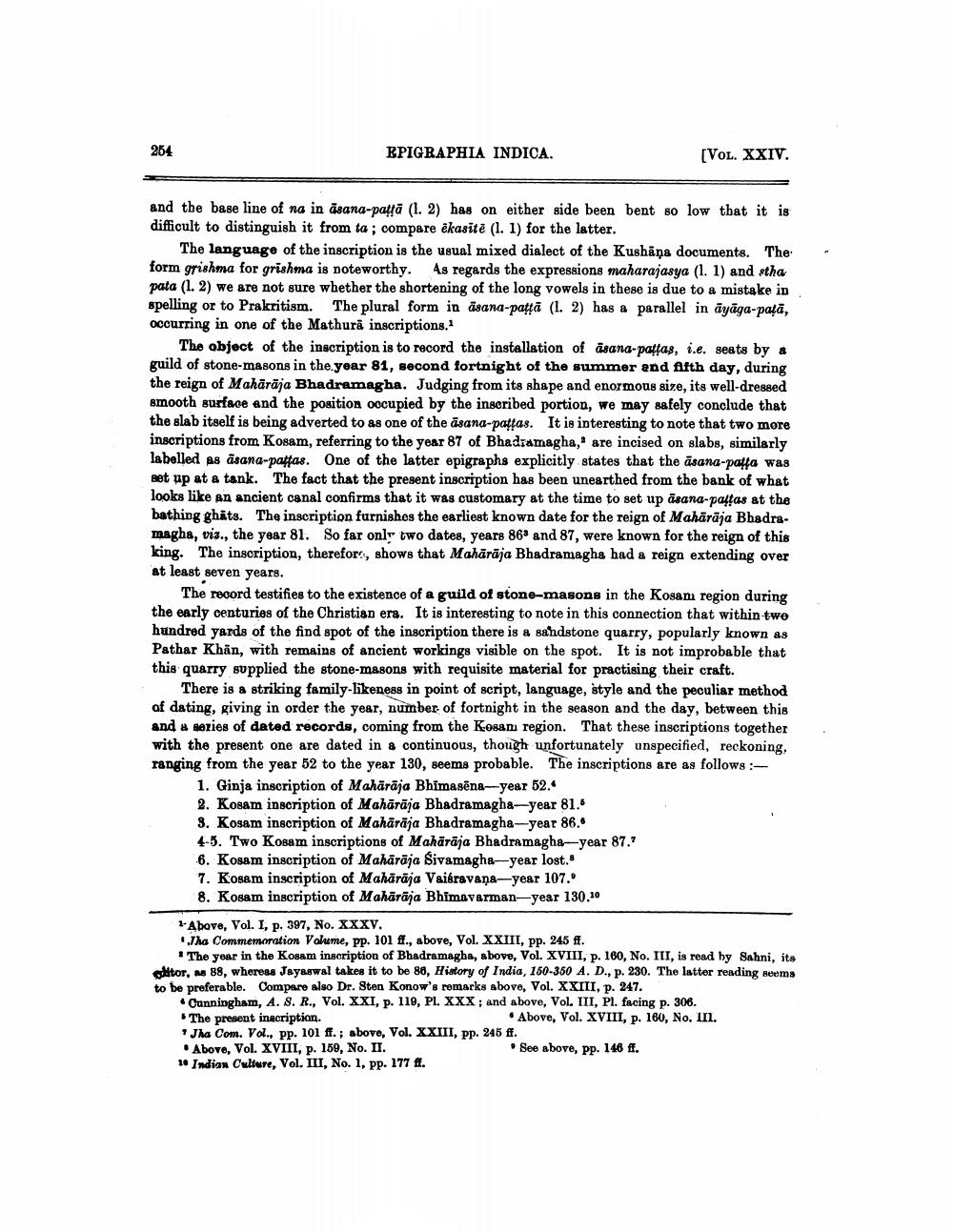________________
254
EPIGRAPHIA INDICA.
[VOL. XXIV.
and the base line of na in äsana-patta (1.2) has on either side been bent so low that it is difficult to distinguish it from ta; compare ēkasite (1.1) for the latter.
The language of the inscription is the usual mixed dialect of the Kushāņa documents. The form grishma for grishma is noteworthy. As regards the expressions maharajasya (1.1) and stha pata (1.2) we are not sure whether the shortening of the long vowels in these is due to a mistake in spelling or to Prakritism. The plural form in asana-patļā (1.2) has a parallel in āyāga-paļā, occurring in one of the Mathura inscriptions.
The object of the inscription is to record the installation of asana-pattas, i.e. seats by & guild of stone-masons in the year 81, second fortnight of the summer and Afth day, during the reign of Mahārāja Bhadramagha. Judging from its shape and enormous size, its well-dressed smooth surface and the position oocupied by the inscribed portion, we may safely conclude that the slab itself is being adverted to as one of the āsana-pattas. It is interesting to note that two more inscriptions from Kosam, referring to the year 87 of Bhadiamagha,' are incised on slabs, similarly labelled as asana-paffas. One of the latter epigraphs explicitly states that the asana-paffa was set up at a tank. The fact that the present inscription has been unearthed from the bank of what looks like an ancient canal confirms that it was customary at the time to set up asana-palgas at the bathing ghits. The inscription furnishes the earliest known date for the reign of Mahārāja Bhadramagha, viz., the year 81. So far only two dates, years 868 and 87, were known for the reign of this king. The inscription, therefore, shows that Mahārāja Bhadramagha had a reign extending over at least seven years.
The record testifies to the existence of a guild of stone-masons in the Kosam region during the early centuries of the Christian era. It is interesting to note in this connection that within two hundred yards of the find spot of the inscription there is a sandstone quarry, popularly known as Pathar Khan, with remains of ancient workings visible on the spot. It is not improbable that this quarry supplied the stone-masons with requisite material for practising their craft.
There is a striking family likeness in point of script, language, style and the peculiar method of dating, giving in order the year, number of fortnight in the season and the day, between this and a series of dated records, coming from the Kosani region. That these inscriptions together with the present one are dated in a continuous, though unfortunately unspecified, reckoning, ranging from the year 52 to the year 130, seems probable. The inscriptions are as follows :
1. Ginja inscription of Mahārāja Bhimasēna--year 52. 2. Kosam inscription of Mahārāja Bhadramagha--year 81. 3. Kosam inscription of Mahārāja Bhadramagha-year 86. 4-5. Two Kosam inscriptions of Mahārāja Bhadramagha--year 87.7 6. Kosam inscription of Mahārāja Sivamagha--year lost." 7. Kosam inscription of Mahārāja Vaisravana-year 107. 8. Kosam inscription of Mahārāja Bhimavarman-year 130.10
-Above, Vol. I, p. 397, No. XXXV. The Commemoration Volume, pp. 101 ff., above, Vol. XXIII, pp. 245 ff.
The year in the Kosam inscription of Bhadramagba, above, Vol. XVIII, p. 160, No. III, is read by Sahni, ita shitor, M 88, whereas Jayaswal takes it to be 80, History of India, 160-360 A. D., p. 230. The latter reading seems to be preferable. Compare also Dr. Sten Konow's remarks above, Vol. XXIII, p. 247.
• Ounningham, A. S. R., Vol. XXI, p. 119, Pl. XXX; and above, Vol. III, Pl. facing p. 306. The present inscription.
Above, Vol. XVIII, p. 160, No. II. Jha Com. Vol., pp. 101 ff.; above, Vol. XXIII, pp. 245 ff. . Above, Vol. XVIII, p. 150, No. II.
See above, pp. 146 ff. 10 Indian Culture, Vol. III, No. 1, pp. 177 ft.




